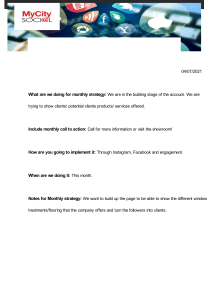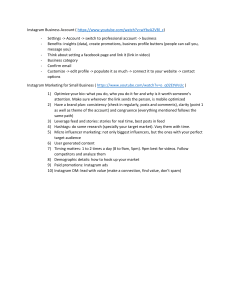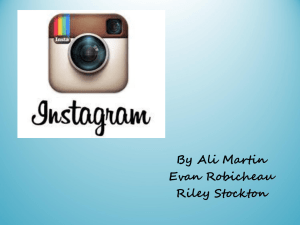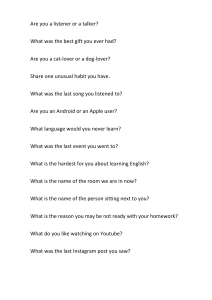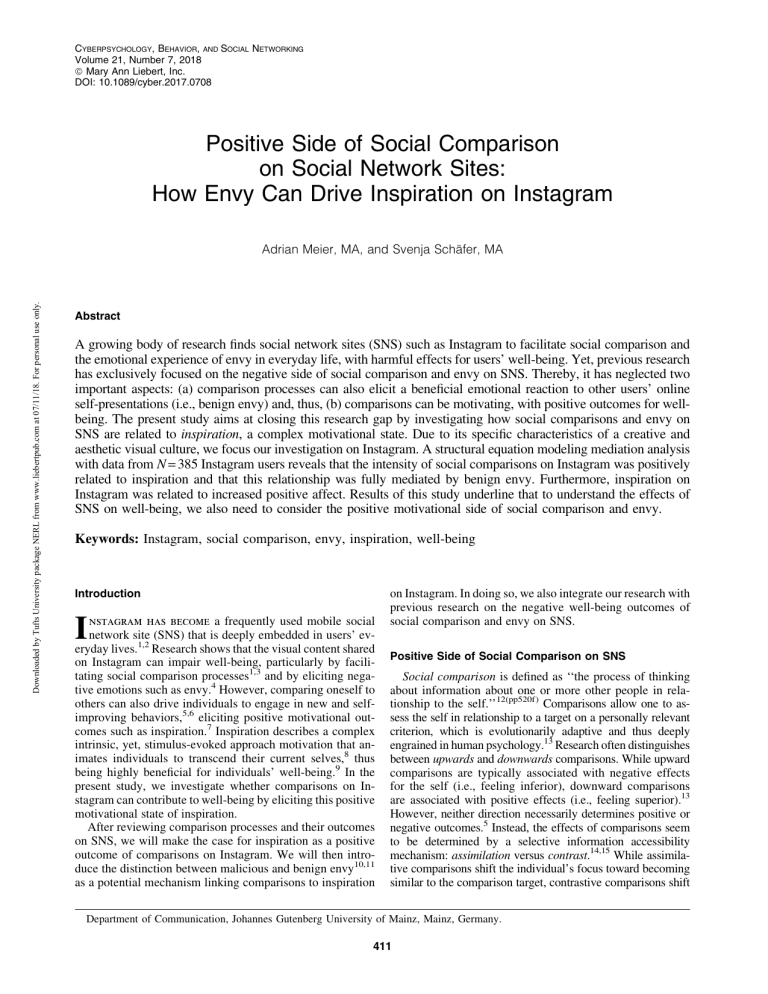
CYBERPSYCHOLOGY, BEHAVIOR, AND SOCIAL NETWORKING
Volume 21, Number 7, 2018
ª Mary Ann Liebert, Inc.
DOI: 10.1089/cyber.2017.0708
Positive Side of Social Comparison
on Social Network Sites:
How Envy Can Drive Inspiration on Instagram
Downloaded by Tufts University package NERL from www.liebertpub.com at 07/11/18. For personal use only.
Adrian Meier, MA, and Svenja Schäfer, MA
Abstract
A growing body of research finds social network sites (SNS) such as Instagram to facilitate social comparison and
the emotional experience of envy in everyday life, with harmful effects for users’ well-being. Yet, previous research
has exclusively focused on the negative side of social comparison and envy on SNS. Thereby, it has neglected two
important aspects: (a) comparison processes can also elicit a beneficial emotional reaction to other users’ online
self-presentations (i.e., benign envy) and, thus, (b) comparisons can be motivating, with positive outcomes for wellbeing. The present study aims at closing this research gap by investigating how social comparisons and envy on
SNS are related to inspiration, a complex motivational state. Due to its specific characteristics of a creative and
aesthetic visual culture, we focus our investigation on Instagram. A structural equation modeling mediation analysis
with data from N = 385 Instagram users reveals that the intensity of social comparisons on Instagram was positively
related to inspiration and that this relationship was fully mediated by benign envy. Furthermore, inspiration on
Instagram was related to increased positive affect. Results of this study underline that to understand the effects of
SNS on well-being, we also need to consider the positive motivational side of social comparison and envy.
Keywords: Instagram, social comparison, envy, inspiration, well-being
Introduction
I
nstagram has become a frequently used mobile social
network site (SNS) that is deeply embedded in users’ everyday lives.1,2 Research shows that the visual content shared
on Instagram can impair well-being, particularly by facilitating social comparison processes1,3 and by eliciting negative emotions such as envy.4 However, comparing oneself to
others can also drive individuals to engage in new and selfimproving behaviors,5,6 eliciting positive motivational outcomes such as inspiration.7 Inspiration describes a complex
intrinsic, yet, stimulus-evoked approach motivation that animates individuals to transcend their current selves,8 thus
being highly beneficial for individuals’ well-being.9 In the
present study, we investigate whether comparisons on Instagram can contribute to well-being by eliciting this positive
motivational state of inspiration.
After reviewing comparison processes and their outcomes
on SNS, we will make the case for inspiration as a positive
outcome of comparisons on Instagram. We will then introduce the distinction between malicious and benign envy10,11
as a potential mechanism linking comparisons to inspiration
on Instagram. In doing so, we also integrate our research with
previous research on the negative well-being outcomes of
social comparison and envy on SNS.
Positive Side of Social Comparison on SNS
Social comparison is defined as ‘‘the process of thinking
about information about one or more other people in relationship to the self.’’12(pp520f) Comparisons allow one to assess the self in relationship to a target on a personally relevant
criterion, which is evolutionarily adaptive and thus deeply
engrained in human psychology.13 Research often distinguishes
between upwards and downwards comparisons. While upward
comparisons are typically associated with negative effects
for the self (i.e., feeling inferior), downward comparisons
are associated with positive effects (i.e., feeling superior).13
However, neither direction necessarily determines positive or
negative outcomes.5 Instead, the effects of comparisons seem
to be determined by a selective information accessibility
mechanism: assimilation versus contrast.14,15 While assimilative comparisons shift the individual’s focus toward becoming
similar to the comparison target, contrastive comparisons shift
Department of Communication, Johannes Gutenberg University of Mainz, Mainz, Germany.
411
Downloaded by Tufts University package NERL from www.liebertpub.com at 07/11/18. For personal use only.
412
the focus toward the differences with the target and what upholds them. Research further indicates that while contrast with
upward targets and assimilation with downward targets decrease well-being, assimilation with upward targets and contrast with downward targets increase well-being.13
With regard to SNS environments, research has so far
overwhelmingly focused on ‘‘negative’’ (i.e., contrastive) upward comparisons.4 Unsurprisingly then, studies on SNS have
predominantly found negative effects of comparisons on wellbeing such as increased depressive symptoms,1,16 higher negative affect,17 and lower positive affect,3 as well as lower (state)
self-esteem.2,17 In contrast, a recent survey found comparisons
on Facebook that were motivated by self-improvement to be
associated with higher positive affect among individuals with
high self-esteem.18 In general, upward comparisons have been
found to elicit positive motivational outcomes such as inspiration.6 Together, this literature points to an important gap in
previous research: comparisons on SNS may also have positive
motivational outcomes. In this study, we specifically focus on
how such comparisons may give rise to inspiration on the understudied SNS Instagram.
Inspiration as a Motivational Outcome of Instagram Use
Inspiration is conceptualized as a complex appetitive
motivational state that can be experienced in various domains
of life.19 Three components define the experience of inspiration: First, transcendence refers to gaining an awareness of
new or better possibilities (e.g., learning about a previously
unknown travel destination from a friend’s SNS post). Second, evocation clarifies that inspiration is, initially, a passive
and stimulus-evoked experience. One is spontaneously inspired by something (e.g., one first encounters information
about said travel destination serendipitously by browsing
one’s SNS feed). Finally, inspiration elicits approach motivation. One is inspired to get active and bring a new and
realizable idea into fruition (e.g., the travel post elicits the
specific idea of planning your next holiday there). Thus, by
spontaneously encountering novel stimuli that resonate with
their current interests, individuals can be inspired to try out
new experiences.20
Instagram, a mobile SNS through which users share pictures and videos on diverse topics (e.g., travel, nature, food,
sports, art), appears as a highly inspiring social environment.
Instagram has a particularly strong visual positivity norm.1
Uploaded content is typically aesthetic and optimized for
self-presentation, but also a result of creative self-expression.
A study by Ouwerkerk and Johnson7 found inspiration to be a
prevalent motive for following and friending others on SNS,
particularly on Instagram. Results indicate that inspiration
was significantly related to time spent on Instagram as well as
the number of followings, but unrelated to time spent on other
SNS. Thus, there is some evidence indicating that Instagram
provides a source of inspiration in users’ everyday lives.
Previous studies identified the intensity with which individuals engage in comparisons as a key driver of inspiration in
general.6 We aim to replicate this link in the Instagram context.
While one would expect upward comparisons to be particularly strongly related to inspiration on Instagram, in this study,
we only consider general, nondirectional social comparison
intensity on Instagram. As self-report scales supposedly measuring upward comparisons often conflate them with negative
MEIER AND SCHÄFER
effects for the self,4 we instead measured social comparison
with neutral, nondirectional intensity items (see Measures for
details).16 Accordingly, we expect the following:
H1: Nondirectional social comparison on Instagram will be
positively related to inspiration on Instagram.
Inspiration activates intrinsically motivated behavior,
which is highly beneficial for affective well-being.21 Accordingly, inspiration has been linked longitudinally and
experimentally to increased positive affect while showing no
relationship to negative affect.9,22 With regard to inspiration
as a result of using Instagram, we thus analogously assume,
H2: Inspiration on Instagram will be (a) positively related
to positive affect and (b) unrelated to negative affect.
So far, it remains unclear how exactly comparisons on
Instagram can contribute to the positive motivational state of
inspiration and, hence, to well-being. Moreover, previous
research clearly shows that comparisons on SNS can negatively impact motivation and well-being.1,2,4 To integrate our
positive view on social comparison with previous research
and to explicate a mechanism linking comparisons to inspiration, we turn our investigation to envy, a key emotional
outcome of upward comparisons.4,15
Malicious and Benign Envy on SNS
Envy is usually defined as ‘‘an unpleasant and often painful
blend of feelings characterized by inferiority, hostility, and
resentment caused by a comparison with a person or group of
persons who possess something we desire.’’23(p49) While
envy has long been seen as an inherently negative and selfharming emotion, recent research has reconceptualized envy
as an emotion that can take two forms: First, malicious envy
or envy proper, which elicits a hostile motivation to pull the
superior comparison target down. Second, benign envy, while
also being mildly frustrating, elicits a more benevolent motivation to self-improve and become more similar to the superior comparison target.10,11
Since the mechanisms underlying assimilation versus
contrast in social comparison are assumed to occur largely
unconsciously,14 they can best be measured indirectly by
assessing their respective emotional outcomes (i.e., malicious
vs. benign envy) via self-reports.15 As an emotional outcome
of upward comparison processes,15 malicious envy indicates
the intensity of contrastive upward comparisons. That is,
malicious envy assesses whether the attentional focus of
comparison lay on the deficits one has in comparison to the
target. Benign envy, in turn, indicates the intensity of assimilative upward comparisons, assessing whether the attentional focus lay on ways to become more similar to the
target.14
Research on envy as a mediator between SNS usage
(specifically, comparisons on SNS) and well-being has so far
exclusively investigated malicious envy—indicating contrastive upward comparisons—and thus consistently found
negative effects.24–27 Yet, the overall literature on SNS observes both positive and negative effects on well-being.28 A
recent review has thus called for a differentiation between
benign and malicious envy as this may ‘‘shed light on the
conflicting findings concerning SNS use.’’4(p47) Indeed, a
Downloaded by Tufts University package NERL from www.liebertpub.com at 07/11/18. For personal use only.
INSTAGRAM INSPIRATION
413
study by Lin and Utz29 found that Facebook postings elicited
much stronger benign than malicious envy.10,29 Thus, while
SNS can certainly elicit malicious envy, benign envy, in
comparison, may be the much more common emotional reaction towards friends’ postings on SNS such as Instagram. It
appears plausible then that social comparisons in the positive, self-optimized, yet ultimately mundane visual network
culture of Instagram can elicit both benign as well as malicious envy. Accordingly, we assume the following:
used Instagram daily (71 percent) and daily users between 14
and 29 were twice as likely to be female than male.
H3: Nondirectional social comparison on Instagram will be
positively related to (a) benign envy and (b) malicious envy
on Instagram.
Social comparison. We measured social comparison intensity on Instagram with two items from the Facebook Social
Comparison Scale16 adapted to Instagram. Of the six original
items, we included only the two items assessing nondirectional
comparison [e.g., ‘‘When I am using Instagram, .’’ (a) ‘‘.I
pay a lot of attention to how I do things compared to how
others do things’’ and (b) ‘‘.I want to find out how well I do
things compared to others’’]. The other four items already
predetermined positive or negative outcomes of downward or
upward comparison, respectively, and were thus omitted.
Turning to the role of envy as a driver of inspiration, benign
envy as a benevolent assimilative emotion should sensitize an
individual for information on how to become similar to a
comparison target and thus facilitate the experience of being
inspired. Malicious envy as a contrastive emotion, in turn,
should decrease the likelihood of such motivating inspiration
experiences.15,30 Thus, we assume the following:
H4: (a) Benign envy will be positively and (b) malicious
envy will be negatively related to inspiration on Instagram.
Since we expect a positive direct effect of social comparison on inspiration (H1), positive relationships between
social comparison and benign and malicious envy (H2), and
opposing relationships between benign versus malicious
envy on inspiration (H3), we state the following mediation
hypotheses:
H5a: Nondirectional social comparison will have a positive
indirect effect on inspiration via benign envy on Instagram.
H5b: Nondirectional social comparison will have a negative
indirect effect on inspiration via malicious envy on Instagram.
Finally, previous research has consistently found two
individual differences, self-esteem and narcissism, to influence how individuals use SNS and how they process
other users’ social information.2,18,31,32 Both traits have
also been identified as crucial personality variables for the
effects of social comparison5,13 and envy.29 We thus include them, together with age and gender, as controls in our
research model.
Measures
All items included in this study were measured on fivepoint Likert scales anchored at 1 (‘‘strongly disagree’’) and 5
(‘‘totally agree’’). For means, SDs, internal consistencies,
and zero-order correlations, see Table 1.
Malicious and benign envy. To measure malicious and
benign envy, we used the scale by Lange and Crusius.10 The
original scale consists of five items for malicious and benign
envy each, which we adapted to assess emotional experiences during typical Instagram use (e.g., ‘‘Seeing other
people’s achievement on Instagram makes me resent them’’
for malicious envy and ‘‘When I envy others on Instagram, I
focus on how I can become equally successful in the future’’
for benign envy).
We used the four-item Inspiration Scale8 to
measure participant’s intensity of inspiration on Instagram.
While two items asked how strongly users experience inspiration on Instagram (e.g., ‘‘When I am on Instagram, I
experience or encounter things that inspire me’’), two additional items referred to inspiration specifically derived from
other users’ photos or videos (e.g., ‘‘When I am on Instagram, I am inspired by the posts of other users to do
something [new]’’).
Inspiration.
Positive and negative affect. We used a 10-item shortversion of the PANAS to assess positive and negative affect.34 Participants were asked to report how intensely they
had experienced different affective states (e.g., excited, determined, distressed, afraid) during the last week.
Methods
Participants and procedure
A total of 385 German-speaking Instagram users were recruited in late 2016 through postings on Facebook and Instagram
profiles as well as in public Facebook groups and via personal
messages. The study was promoted as a study about ‘‘Instagram
use,’’ avoiding any positive or negative connotation. Having an
Instagram account was mandatory to participate.
Participants were aged 18–52 years (M = 22.64; SD = 4.00),
predominantly highly educated (77 percent students), female
(82 percent), and reported frequent Instagram usage, with 89
percent using it at least once a day. The sample approximates
results of a 2015 representative survey of German SNS users,33 where 14–29-year-olds made up 70 percent of all Instagram users. Fourteen to 29-year-olds also predominantly
Trait narcissism and trait self-esteem. We measured
these control variables using 10-item versions of the two
most commonly used scales, the Narcissistic Personality
Inventory35 and the Rosenberg Self-Esteem Scale.36
Results
Exploratory analyses
On the five-point scales used in this study, participants
reported substantial levels of inspiration on Instagram
(M = 3.62, SD = 1.04) and higher levels of benign (M = 2.16,
SD = 1.00) than malicious envy (M = 1.44, SD = 0.69).
Moreover, inspiration showed significant zero-order relationships with most of the other investigated constructs
(Table 1).
—
-0.19***
10
—
0.10
-0.24***
9
—
0.35***
0.10
-0.06
8
—
-0.31***
-0.01
0.02
0.07
7
—
0.10
0.25***
0.16**
0.01
0.00
6
—
0.16**
-0.11*
0.11*
0.02
-0.06
0.08
5
—
0.34***
0.01
0.02
-0.15**
0.17**
-0.14**
-0.05
4
0.69
1.00
1.04
0.71
0.74
0.63
0.67
4.00
—
1.44
2.16
3.62
3.21
2.09
4.09
2.93
22.64
—
0.87
0.89
0.93
0.70
0.72
0.85
0.81
—
—
—
0.97
2.10
1. Nondirectional social comparison
on Instagram
2. Malicious envy on Instagram
3. Benign envy on Instagram
4. Inspiration on Instagram
5. Positive affect
6. Negative affect
7. Trait self-esteem
8. Trait narcissism
9. Age
10. Gender
0.74
0.35***
0.46***
0.14**
-0.04
0.09
-0.24***
0.06
-0.11**
-0.03
—
0.38***
0.00
-0.08
0.17**
-0.23***
0.10*
-0.12*
-0.07
3
2
1
a
SD
M
Variable
Table 1. Means, Standard Deviations, Internal Consistencies (Cronbach’s a), and Zero-Order
Correlations for Structural Equation Modeling Variables
Downloaded by Tufts University package NERL from www.liebertpub.com at 07/11/18. For personal use only.
Note. Based on N = 385 participants and two-tailed significance tests. All scales are five-point Likert-scales with high values representing high levels of the respective construct. All scales,
except the personality traits and affect, were assessed with respect to participants’ ‘‘typical Instagram usage.’’ Positive and negative affect were measured with respect to participants’ ‘‘feelings
in the last week.’’ Gender is coded as 0 = male, 1 = female. *p < 0.05, **p < 0.01, ***p < 0.001.
MEIER AND SCHÄFER
—
414
Testing the hypothesized model
We thus continued our analysis and tested hypotheses with
structural equation modeling (SEM) using the R package
lavaan (version 0.5-23.1097).37 All constructs (see H1–H5)
were treated as latent variables. The overall measurement
model (i.e., without any structural paths) showed an adequate fit [v2(961) = 1,826.558, p < 0.001; v2/df = 1.900, comparative fit index, CFI = 0.890; root-mean-squared error of
approximation, RMSEA = 0.048 (90 percent confidence interval, CI: 0.045–0.052); SRMR = 0.062].
However, since the CFI was below 0.900,38 we implemented changes suggested by modification indices and
included covariances between some of the error terms of items
measuring the controls, narcissism and self-esteem. Likewise,
self-esteem and narcissism as well as malicious and benign
envy were allowed to covary. This improved the measurement model to a satisfying level [v2(957) = 1,622.237,
p < 0.001; v2/df = 1.695, CFI = 0.916; RMSEA = 0.042 (90
percent CI: 0.039–0.046); SRMR = 0.061]. The structural
model tested hypotheses based on this modified measurement model. Moreover, we controlled for the variance
explained by age, gender, trait narcissism, and trait selfesteem in all model constructs (see H1–H5).
The SEM (Fig. 1) showed an adequate fit to the data
[v2(1,043) = 1,751.376, p < 0.001; v2/df = 1.679, CFI = 0.911;
RMSEA = 0.042 (90 percent CI: 0.039–0.046); SRMR =
0.062]. Results of the SEM and our mediation analysis revealed that social comparison did not have a significant direct relationship with inspiration (b = 0.03, p > 0.05), but
showed a significant total relationship (b = 0.21, p < 0.01),
suggesting full mediation via envy (see H5). Based on this
significant overall relationship, we accept H1. As expected in
H2a and H2b, inspiration on Instagram was positively related
to positive affect (b = 0.17, p < 0.01) and showed no significant relationship with negative affect (b = -0.09, p > 0.05).
Confirming H3a and H3b, social comparison was positively
related to both benign (b = 0.50, p < 0.001) and malicious
envy (b = 0.31, p < 0.001). As predicted in H4a, benign envy
was positively related to inspiration (b = 0.44, p < 0.001).
However, the negative relationship between malicious envy
and inspiration was only marginally significant (b = -0.11,
p = 0.09), leading to a rejection of H4b.
We continued by investigating whether benign and malicious
envy mediated the relationship between social comparison and
inspiration (H5a and H5b). Significance of indirect relationships
was tested with 5,000 bias-corrected bootstrap subsamples on a
95 percent CI. In line with H5a, social comparison showed an
indirect relationship with inspiration via benign envy (b = 0.22,
p < 0.001, LLCI = 0.166, ULCI = 0.422). The indirect relationship with inspiration via malicious envy did not reach significance (b = -0.03, p > 0.05, LLCI = -0.106, ULCI = 0.003).
Consequently, H5b was rejected.
Supplementary analyses
Since the paths between social comparison to benign envy,
inspiration, and positive affect all reached significance, we
tested a serial mediation that considered these paths simultaneously. Indeed, we found the relationships between social
comparison and positive affect to be mediated through benign envy and inspiration (b = 0.04, p < 0.05, LLCI = 0.004,
ULCI = 0.061). The serial mediation from social comparison
Downloaded by Tufts University package NERL from www.liebertpub.com at 07/11/18. For personal use only.
INSTAGRAM INSPIRATION
415
FIG. 1. Structural equation model of the hypothesized relationships (H1–H5), with age, gender, trait narcissism, and trait
self-esteem as controls. Note. Observed structural equation model based on data from N = 385 participants. Fit indices are
v2(1043) = 1751.376, p < 0.001; v2/df = 1.679; CFI = 0.911; RMSEA = 0.042 (90% C.I.: 0.039, 0.046); SRMR = 0.062. Scores
in the figure represent standardized path coefficients. In all latent constructs, we controlled for variance explained by age,
gender, trait narcissism, and trait self-esteem (not displayed for sake of clarity). Significance of indirect effects was tested
with 5000 bias-corrected bootstrap sub-samples on a 95% confidence interval. {p < 0.10, *p < 0.05, **p < 0.01, ***p < 0.001.
SC, social comparison.
through malicious envy and inspiration on negative affect,
however, was not significant (b = 0.00, p > 0.05, LLCI =
-0.001, ULCI = 0.008). Integrating both serial mediations
into the model did not change any of the relationships reported in Figure 1.
Discussion
Summary and contribution
The present study investigated whether social comparisons
on the popular picture- and video-sharing SNS Instagram can
also be beneficial for users’ well-being by facilitating the motivational experience of inspiration. Overall, we contribute to
the literature on SNS and well-being in four ways: First, our
results provide clear evidence for a link between social comparison and inspiration on Instagram. Crucially, we observed a
significant relationship between social comparison and inspiration, which was found to be fully mediated by benign envy,
an emotional outcome of assimilative upward comparisons.
Second, increased inspiration on Instagram was related to
higher levels of positive affect. In line with general inspiration
research,9,22 this underlines the positive well-being outcomes
that Instagram users can derive from experiencing increased
approach motivation in the form of inspiration. The present
study thus suggests that users can improve the short-term affective outcomes of their Instagram usage by following content
that inspires them to pursue new and personally interesting
activities (e.g., traveling, sports, cooking), akin to, for example,
reading special interest magazines.
Third, while our results show that malicious envy seems to
be largely irrelevant for the level of inspiration that users associate with Instagram, our findings do not refute that malicious
envy can negatively affect well-being, as consistently found in
previous studies.24,27 Yet, we would not have been able to
detect the positive relationship between envy and inspiration
had we only investigated malicious envy, as previous studies
have. In the broader context of research on social comparison
and envy on SNS, this underlines the need to approach psychological processes more comprehensively—that is, including
a potential positive side—when assessing the supposedly detrimental effects of user engagement with SNS on well-being.
Finally, by focusing on Instagram, we contribute to SNS
research beyond Facebook. It can be assumed that the positive experience of inspiration results from Instagram-specific
visual content as well as Instagram’s particular functionality
(e.g., searching and browsing via content- or locationspecific hashtags). Other SNS (e.g., Pinterest vs. Facebook)
might evoke similar or different outcomes, respectively, due
to their distinct content and design properties. Our study thus
underlines the need to differentiate between SNS when investigating their role for well-being.
Limitations and future research
While the present study advances previous research on SNS
and well-being, it certainly comes with limitations. First, the
analysis is limited by the cross-sectional nature of our data.
Results should not be mistaken for causal evidence. Second,
although we investigated a large dataset from N = 385 Instagram
users, our convenience sample consisted of mostly young, highly
educated, and female participants who frequently used Instagram. Even though these skewed distributions are somewhat
reflective of German Instagram users,33 the considerable bias in
our sample as well as the nonrandom sampling procedure limit
interpretations of our results to the investigated data.
Downloaded by Tufts University package NERL from www.liebertpub.com at 07/11/18. For personal use only.
416
Future SNS research on the effects of social comparison
and envy can build on this study in numerous ways. For
instance, our study did not incorporate several important
moderators of social comparison processes on SNS, such as
tie strength,29 the amount of strangers that users follow,1 or
the attainability of comparison standards.6 Comparing the
inspirational effects of postings from strong versus weak tie
users who depict their successes with ‘‘hubristic pride’’ rather than humility may be a worthwhile task for future research.4 Moreover, assessing whether social comparison and
envy can have similar beneficial effects on other SNS (e.g.,
Pinterest or Facebook) remains a pressing task.
Since our results refer to inspiration derived from overall
Instagram use, it seems particularly important for future research to distinguish between inspiration derived from different Instagram contents. For example, ‘‘fitspiration’’ imagery
has been linked to lower body image and mood among female
undergraduates when compared to travel imagery.39 Thus,
there might also be a dark side to inspiration derived from
certain contents on SNS. Nonetheless, results of our study
point to a positive association between overall Instagram inspiration and affective well-being.
Conclusion
In conclusion, results of this study indicate that mundane
forms of Instagram use can provide users with new ideas and
impulses, potentially motivating them to transcend their
current selves and strive for self-improvement. We found a
positive association between such ‘‘Instagram inspiration’’
and users’ affective well-being and further identified a relevant psychological mechanism driving inspiration: Benign
envy as an emotional outcome of assimilative upward comparisons sensitizes individuals for social information on how
to self-improve and close up to their peers, hence, facilitating
inspiration. To complete the picture of the effects of SNS on
well-being, future research will thus benefit from investigating not just the negative but also the positive side of social
comparisons and envy on SNS.
Acknowledgments
We thank Vanessa Melching and Kerstin Bonni for their
efforts in researching some of the measures and collecting the
data for this study. Our thanks also go to Leonard Reinecke
and three anonymous reviewers for their helpful comments
on earlier versions of this article.
Author Disclosure Statement
No competing financial interests exist.
References
1. Lup K, Trub L, Rosenthal L. Instagram #Instasad? Exploring
associations among Instagram use, depressive symptoms,
negative social comparison, and strangers followed. Cyberpsychology, Behavior, and Social Networking 2015;
18:247–252.
2. Stapleton P, Luiz G, Chatwin H. Generation validation: the
role of social comparison in use of Instagram among emerging
adults. Cyberpsychology, Behavior, and Social Networking
2017; 20:142–149.
MEIER AND SCHÄFER
3. de Vries DA, Möller AM, Wieringa MS, et al. Social comparison as the thief of joy: Emotional consequences of viewing
strangers’ Instagram posts. Media Psychology 2018; 21:222–
245.
4. Appel H, Gerlach AL, Crusius J. The interplay between
Facebook use, social comparison, envy, and depression.
Current Opinion in Psychology 2016; 9:44–49.
5. Buunk BP, Collins RL, Taylor SE, et al. The affective
consequences of social comparison: Either direction has its
ups and downs. Journal of Personality and Social Psychology 1990; 59:1238–1249.
6. Lockwood P, Kunda Z. Superstars and me: Predicting the
impact of role models on the self. Journal of Personality
and Social Psychology 1997; 73:91–103.
7. Ouwerkerk JW, Johnson BK. Motives for online friending
and following: The dark side of social network site connections. Social Media + Society 2016; 2:1–13.
8. Thrash TM, Elliot AJ. Inspiration as a psychological construct. Journal of Personality and Social Psychology 2003;
84:871–889.
9. Thrash TM, Elliot AJ, Maruskin LA, et al. Inspiration and
the promotion of well-being: Tests of causality and mediation. Journal of Personality and Social Psychology 2010;
98:488–506.
10. Lange J, Crusius J. Dispositional envy revisited: Unraveling the motivational dynamics of benign and malicious
envy. Personality and Social Psychology Bulletin 2015; 41:
284–294.
11. van de Ven N, Zeelenberg M, Pieters R. Leveling up and
down: The experiences of benign and malicious envy.
Emotion 2009; 9:419–429.
12. Wood JV. What is social comparison and how should we
study it? Personality and Social Psychology Bulletin 1996;
22:520–537.
13. Buunk AP, Gibbons FX. Social comparison: The end of a
theory and the emergence of a field. Organizational Behavior and Human Decision Processes 2007; 102:3–21.
14. Mussweiler T, Rüter K, Epstude K. The ups and downs of
social comparison: Mechanisms of assimilation and contrast. Journal of Personality and Social Psychology 2004;
87:832–844.
15. Smith RH. (2000) Assimilative and contrastive emotional
reactions to upward and downward social comparisons. In
Suls J, Wheeler L, eds. Handbook of social comparison:
Theory and research. Boston, MA: Springer, pp. 173–
200.
16. Steers M-LN, Wickham RE, Acitelli LK. Seeing everyone
else’s highlight reels: How Facebook usage is linked to
depressive symptoms. Journal of Social and Clinical Psychology 2014; 33:701–731.
17. Vogel EA, Rose JP, Okdie BM, et al. Who compares and
despairs? The effect of social comparison orientation on
social media use and its outcomes. Personality and Individual Differences 2015; 86:249–256.
18. Cramer EM, Song H, Drent AM. Social comparison on
Facebook: Motivation, affective consequences, self-esteem,
and Facebook fatigue. Computers in Human Behavior
2016; 64:739–746.
19. Thrash TM, Elliot AJ. Inspiration: Core characteristics,
component processes, antecedents, and function. Journal of
Personality and Social Psychology 2004; 87:957–973.
20. Thrash TM, Moldovan EG, Oleynick VC, et al. The psychology of inspiration. Social and Personality Psychology
Compass 2014; 8:495–510.
Downloaded by Tufts University package NERL from www.liebertpub.com at 07/11/18. For personal use only.
INSTAGRAM INSPIRATION
21. Ryan RM, Deci EL. Self-determination theory and the facilitation of intrinsic motivation, social development, and
well-being. American Psychologist 2000; 55:68–78.
22. Thrash TM. (2007) Differentiation of the distributions of
inspiration and positive affect across days of the week: An
application of logistic multilevel modeling. In Ong AD, van
Dulmen MHM, eds. Oxford handbook of methods in positive
psychology. Oxford: Oxford University Press, pp. 515–529.
23. Smith RH, Kim SH. Comprehending envy. Psychological
Bulletin 2007; 133:46–64.
24. Krasnova H, Widjaja T, Buxmann P, et al. Why following
friends can hurt you: An exploratory investigation of the
effects of envy on social networking sites among collegeage users. Information Systems Research 2015; 26:585–
605.
25. Lim M, Yang Y. Effects of users’ envy and shame on social
comparison that occurs on social network services. Computers in Human Behavior 2015; 51:300–311.
26. Tromholt M. The Facebook experiment: Quitting Facebook
leads to higher levels of well-being. Cyberpsychology,
Behavior, and Social Networking 2016; 19:661–666.
27. Verduyn P, Lee DS, Park J, et al. Passive Facebook usage
undermines affective well-being: experimental and longitudinal evidence. Journal of Experimental Psychology:
General 2015; 144:480–488.
28. Verduyn P, Ybarra O, Résibois M, et al. Do social network
sites enhance or undermine subjective well-being? A critical review. Social Issues and Policy Review 2017; 11:274–
302.
29. Lin R, Utz S. The emotional responses of browsing Facebook: Happiness, envy, and the role of tie strength. Computers in Human Behavior 2015; 52:29–38.
30. Nabi RL, Keblusek L. Inspired by hope, motivated by envy:
Comparing the effects of discrete emotions in the process
of social comparison to media figures. Media Psychology
2014; 17:208–234.
31. Dumas TM, Maxwell-Smith M, Davis JP, et al. Lying or
longing for likes?: Narcissism, peer belonging, loneliness
and normative versus deceptive like-seeking on Instagram
417
32.
33.
34.
35.
36.
37.
38.
39.
in emerging adulthood. Computers in Human Behavior
2017; 71:1–10.
Forest AL, Wood JV. When social networking is not
working: Individuals with low self-esteem recognize but do
not reap the benefits of self-disclosure on Facebook. Psychological Science 2012; 23:295–302.
Tippelt F, Kupferschmitt T. Social Web: Ausdifferenzierung
der Nutzung—Potenziale für Medienanbieter. Ergebnisse
der ARD/ZDF-Onlinestudie 2015 [Social web: Differentiation of uses—Potentials for media vendors. Results of the
ARD/ZDF Online Study 2015]. Media Perspektiven 2015;
2015:442–452.
Mackinnon A, Jorm AF, Christensen H, et al. A short form
of the positive and negative affect schedule: Evaluation of
factorial validity and invariance across demographic variables in a community sample. Personality and Individual
Differences 1999; 27:405–416.
Raskin RN, Hall CS. A narcissistic personality inventory.
Psychological Reports 1979; 45:590.
Rosenberg M. (1965) Society and the adolescent selfimage. Princeton: Princeton University Press.
Rosseel Y. lavaan: An R package for structural equation
modeling. Journal of Statistical Software 2012; 48:1–36.
Little TD. (2013) Longitudinal structural equation modeling. New York: Guilford Press.
Tiggemann M, Zaccardo M. ‘‘Exercise to be fit, not skinny’’: The effect of fitspiration imagery on women’s body
image. Body Image 2015; 15:61–67.
Address correspondence to:
Adrian Meier
Department of Communication
Johannes Gutenberg University of Mainz
Jakob-Welder-Weg 12
Mainz 55099
Germany
E-mail: meier@uni-mainz.de
